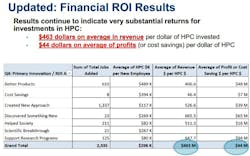Here Comes the Simulation Revolution! Part 2
In Part 1 we discussed the concept of the Democratization of Simulation, explaining how having the value of CAD, FEA, computer-aided engineering (CAE), and simulation reserved to experts can stifle innovation. In Part 2 we review the implementation challenges and return on investment (ROI) that the democratization of simulation can bring.
Challenge: Quantifying ROI
There are three key challenges associated with ROI calculations related to democratizing simulation:
The efficiency trap. One common method of calculating benefits focuses on increased efficiency for engineering. However, this approach has its drawbacks as engineers by nature are likely to use the same amount of time and effort to enhance designs. What’s more, in the front office, is finance just going to ask “Who are you letting go?”
Disconnect from technology and business goals. Those who understand the technology requirements often do not also understand its relationship or are uncomfortable with formulating and communicating technical requirements.
The higher the business value, the harder it is to quantify. This is true for any business activity as it transitions from tactical to strategic importance. Quantifying the value of an expected reduction in cost or schedule can be challenging, but it is much easier than quantifying value for increasing quality, performance, or innovation. What is the value of a product recall that did not have to happen?
Image courtesy of Kinetic Vision
Challenge: A Perceived Threat
So with such advantages, why aren’t all design and manufacturing organizations taking advantage of Democratized Simulation? As you can imagine, embracing this level of change clearly represents a paradigm shift for organizations as a whole, as well as analysis resources within any given company. Knowing the complexities of their job and unsure of an ability to accurately and completely replicate that knowledge (along with other intangibles) is understandably concerning.
Consequently, CAE experts may be hesitant to endorse such an initiative. Still others may see it as diminishing their value in the eyes of the company. There is after all a certain level of prestige and job security that comes with being a sole source for anything within an organization.
“Democratization isn’t a turf war,” explained Juan Betts, managing director for Front End Analytics, LLC. “And analysts should not view it as a threat. In no way is their role being lessened and they are not being asked to relinquish control. Rather through democratization tactics, such as simulation applications, analysts are taking on a greater role with his/her expertise being leveraged exponentially throughout the company.
“When you look at some of the huge successes associated with Democratizing Simulation, one thing that they all have in common is the willingness of the CAE experts to champion such a cause.”
Challenge: Implementation
While some lacking a holistic view may see democratization as a threat to their domain, the biggest obstacle to widespread implementation is a general lack of understanding as to how or where to begin. Until now, at least, this has been understandable as engineers were forced to scour the internet and similar resources for bits of disjointed information. At the same time success stories were not well-documented or readily available.
There are new online resource centers designed to support industry’s growing demand for democratization. These resources are a collaborative effort among simulation experts, industry end-users, and solution providers, sharing a mission to create an open community to access and share useful, vendor-agnostic information. The portal provides end-users with knowledge and solutions for Democratizing Simulation.
A Hyperion Research study on Return on Investment on using High Performance Computing (HPC) measures how HPC investments are related to improved economic success and increased scientific innovation.
Success Stories
And so the question is: Have organizations who have taken steps to democratize simulation found it to be worth the effort? While some prefer to keep results close to the vest, there are organizations that are loudly beating the Democratizing Simulation drum to help champion widespread adoption. Here are a couple of examples:
GKN Automotive implementation results:
- Removes the bulk of routine analysis work and tedious report creation from the CAE Expert role, freeing them to work on more complex problems
- Allows a non-expert user to investigate many iterations and establish a design-intent before expert involvement
- Data interrogation remains available for expert users, but is not required to execute the process
- Automation activity drives process refinement and structure; creating a globally consistent methodology
American Axle & Manufacturing implementation results:
- Average 75% time reduction for each analysis iteration
- Approximately $130,000 in annual cost savings at a single engineering site
- Improved quality through globally enforced standards and practices which remove human error
- Ability to run many more Noise Vibration & Harshness (NVH) analysis iterations, leading to more design decisions, earlier
- Ability to redeploy resources as less experienced engineers are now able to safely run simulations
While results will certainly differ from one implementer to the next, it’s safe to say that organizations that have Democratized Simulation are seeing measurable improvements related to cost-savings, development time, and overall efficiency. What’s more, companies are leveraging expert analysts more fully allowing them to tackle more complex projects while empowering non-experts to take on more day-to-day analysis tasks. (These and other case studies are available at Revolution in Simulation).
A Journey to Democratization
When it takes days or weeks of experts’ time to analyze design iterations, it is hardly surprising that CAE has not achieved its potential impact on product development. The faster and more automatically new designs can be analyzed by experts and non-experts, the more alternatives can be considered. Democratizing Simulation is a process representing a break from traditional processes and product development strategies. As such it truly can be a paradigm shift for most organizations.
These collaborative online resources should be vendor-agnostic which are developed and maintained by a collaborative community to significantly increase the value of a company’s simulation (CAE) investments. Look for web portals that provide access to the latest success stories, news, articles, whitepapers, thought leadership blogs, and more to help industry democratize the power of simulation across their engineering, manufacturing, service, supply chain, and R&D organizations.
This collaborative resource should have feature that allow and encourage questions and participation in discussions with industry peers and moderators who are identified by their subject matter expertise and to contribute to this community effort. It can also be beneficial to find a collaborative online resource that has access to simulation specialists, industry organizations, and special interest discussion groups, along with software and consulting service providers, to accelerate the return on a company’s simulation investments.
Democratizing simulation is gaining speed and momentum. Now is the time to take the steps to learn what the initiative is all about and see if your organization is ready to jump on board.
If you have questions, interested in taking a deeper dive, or just wish to learn a little more, visit Revolution in Simulation.
Robert Farrell, Jr. is president of Farrell Marcom, LLC.



